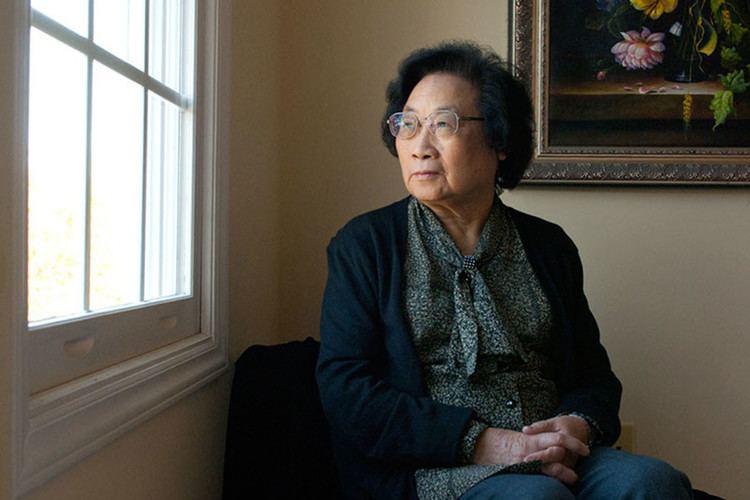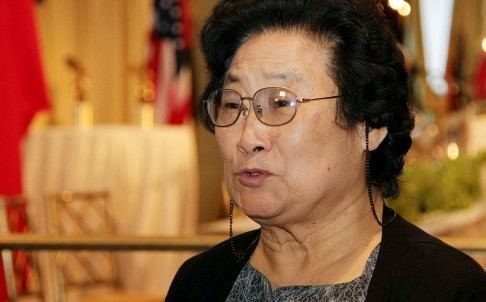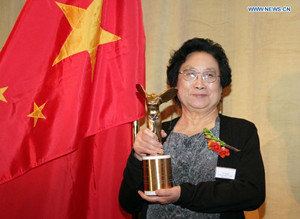Residence Beijing, China Spouse Li Tingzhao (m. 1963) | Role Chemist Name Tu Youyou | |
 | ||
Born 30 December 1930 (age 94) Ningbo, Zhejiang, China ( 1930-12-30 ) Alma mater Peking University Medical School / Beijing Medical College (now Peking University Health Science Center) Influences Ge Hong (Chinese herbology); Mao Zedong (promoting integrated traditional Chinese and modern Western medicine; ordering Project 523) Education Peking University Health Science Center (1951–1955) Similar People Satoshi Omura, William C Campbell, Takaaki Kajita | ||
China s tu youyou receives nobel prize in medicine
Tu Youyou (Chinese: 屠呦呦; pinyin: Tú Yōuyōu; born 30 December 1930) is a Chinese pharmaceutical chemist and educator. She is best known for discovering artemisinin (also known as qinghaosu) and dihydroartemisinin, used to treat malaria, and which has saved millions of lives. Tu Youyou's discovery of artemisinin and its treatment of malaria is regarded as a significant breakthrough in 20th century tropical medicine and an important health improvement for people of tropical developing countries in South Asia, Africa, and South America. For her work, Tu received the 2011 Lasker Award in clinical medicine and the 2015 Nobel Prize in Physiology or Medicine jointly with William C. Campbell and Satoshi Ōmura. Tu is the first Chinese Nobel laureate in physiology or medicine and the first female citizen of the People's Republic of China to receive a Nobel Prize in any category, as well as the first Chinese person to receive the Lasker Award. Tu Youyou was born and educated and carried out research exclusively in China.
Contents
- China s tu youyou receives nobel prize in medicine
- Who inspires you chemist tu youyou hervoiceismyvoice
- Background
- Biography
- Family
- Name
- Schistosomiasis
- Malaria
- Awards
- References

Who inspires you chemist tu youyou hervoiceismyvoice
Background

Tu Youyou carried on her work in the 1960s and 70s during China's Cultural Revolution, when scientists were denigrated as one of the nine black categories in society according to Maoist theory (or possibly that of the Gang of Four).

In 1967, during the Vietnam War, Ho Chi Minh, the leader of North Vietnam, which was at war against South Vietnam and the United States, asked Chinese Premier Zhou Enlai for help in developing a malaria treatment for his soldiers trooping down the Ho Chi Minh trail, where a majority came down with a form of malaria which is resistant to chloroquine. Because malaria was also a major cause of death in China's southern provinces including Hainan, Yunnan, Guangxi, and Guangdong, Zhou Enlai convinced Mao Zedong to set up a secret drug discovery project, named Project 523 after its starting date, 23 May 1967. Upon joining the project unit, Tu was initially sent to Hainan where she studied patients who had been infected with the disease. During the time she spent there, her husband was banished to the countryside, meaning that her daughter had to be entrusted to a nursery in Beijing.

Scientists worldwide had screened over 240,000 compounds without success. In 1969, Tu Youyou, then 39 years old, had an idea of screening Chinese herbs. She first investigated the Chinese medical classics in history, visiting practitioners of traditional Chinese medicine all over the country on her own. She gathered her findings in a notebook called A Collection of Single Practical Prescriptions for Anti-Malaria. Her notebook summarized 640 prescriptions. Her team also screened over 2,000 traditional Chinese recipes and made 380 herbal extracts, which were tested on mice.
One compound was effective, sweet wormwood (Artemisia annua), which was used for "intermittent fevers," a hallmark of malaria. As Tu also presented at the project seminar, its preparation was described in a 1,600-year-old text, in a recipe titled, "Emergency Prescriptions Kept Up One's Sleeve". At first, it didn't work, because they extracted it with traditional boiling water. Tu Youyou discovered that a low-temperature extraction process could be used to isolate an effective antimalarial substance from the plant; Tu says she was influenced by a traditional Chinese herbal medicine source, The Handbook of Prescriptions for Emergency Treatments, written in 340 by Ge Hong, which states that this herb should be steeped in cold water. This book contained the useful reference to the herb: "A handful of qinghao immersed with two litres of water, wring out the juice and drink it all." After rereading the recipe, Tu realised the hot water had already damaged the active ingredient in the plant; therefore she proposed a method using low-temperature ether to extract the effective compound instead. The animal tests showed it was completely effective in mice and monkeys.
Furthermore, Tu volunteered to be the first human subject. "As head of this research group, I had the responsibility" she said. It was safe, so she conducted successful clinical trials with human patients. Her work was published anonymously in 1977. In 1981, she presented the findings relating to artemisinin at a meeting with the World Health Organization.
Biography
Tu Youyou was born in Ningbo, Zhejiang, China on 30 December 1930. She attended Xiaoshi Middle School for junior high school and the first year of high school, before transferring to Ningbo Middle School in 1948. From 1951 to 1955, she attended Peking University Medical School / Beijing Medical College. Tu studied at the Department of Pharmaceutical Sciences, and graduated in 1955. Later Tu was trained for two and a half years in traditional Chinese medicine.
After graduation, Tu worked at the Academy of Traditional Chinese Medicine (now the China Academy of Traditional Chinese Medical Sciences) in Beijing. She was promoted to a Researcher (研究员, the highest researcher rank in mainland China equivalent to the academic rank of a full professor) in 1980 shortly after the Chinese economic reform began in 1978. In 2001 she was promoted to academic advisor for doctoral candidates. Currently she is the Chief Scientist in the Academy.
As of 2007, her office is in an old apartment building in Dongcheng District, Beijing.
Before 2011, Tu Youyou had been obscure for decades, and is described as "almost completely forgotten by people".
Tu is regarded as the Professor of Three Noes – no postgraduate degree (there was no postgraduate education then in China), no study or research experience abroad, and not a member of any Chinese national academies, i.e. Chinese Academy of Sciences and Chinese Academy of Engineering. Up until 1979, there were no postgraduate degree programs in China, and China was largely isolated from the rest of the world. Tu is now regarded as a representative figure of the first generation of Chinese medical workers since the establishment of the People's Republic of China in 1949.
Family
Tu Youyou and her husband, Li Tingzhao (李廷钊), a metallurgical engineer, live in Beijing. Li Tingzhao was Tu's classmate at Xiaoshi Middle School. Her younger daughter lives in Beijing, seen in a few pictures. Her older daughter lives in the United States, along with her husband and daughter, seen in a few pictures (Tu Youyou's son in law and granddaughter). Tu's maternal grandfather, Yao Yongbai (姚咏白), was the first Director of National Treasury Administration after its reform. Her uncle, Yao Qingsan (姚庆三), was an eminent economist, banker, and the first Keynesian in China.
Name
My [first] name, Youyou, was given by my father, who adapted it from the sentence ‘呦呦鹿鸣, 食野之蒿’ translated as ‘Deer bleat “youyou” while they are eating the wild Hao’ in the Chinese Book of Odes. How this links my whole life with qinghao will probably remain an interesting coincidence forever.
Schistosomiasis
During her early years, Tu studied Lobelia chinensis, a traditional Chinese medicine, for curing schistosomiasis, caused by parasitic worms which infect the urinary tract or the intestines, which was widespread in the first half of the 20th century in South China.
Malaria
Tu started her malaria research in China when the Cultural Revolution was in progress. In early 1969, Tu was appointed head of the project, named Project 523 research group at her institute. She collected 2000 candidate recipes, ancient texts, and folk remedies for possible leads for her research. By 1971, her team had made 380 extracts from 200 herbs, and discovered the extracts from qinghao (Artemisia annua, sweet wormwood) looked particularly promising in dramatically inhibiting Plasmodium growth in animals. Tu found the way to extract it and her innovations boosted potency and slashed toxicity of this extract. In 1972, she and her colleagues obtained the pure substance and named it qinghaosu (青蒿素), or artemisinin as it is commonly called in the west, which has saved millions of lives, especially in the developing world. Tu also studied the chemical structure and pharmacology of artemisinin. Tu's group first determined the chemical structure of artemisinin. In 1973, Tu wanted to confirm the carbonyl group in the artemisinin molecule, therefore she accidentally synthesized dihydroartemisinin. For her work, she was awarded the Nobel Prize in Medicine on 5 October 2015.
